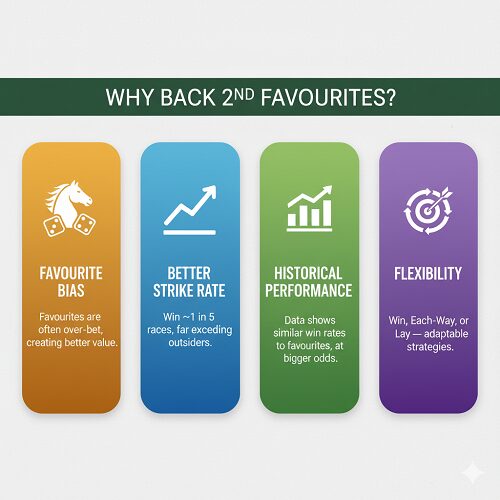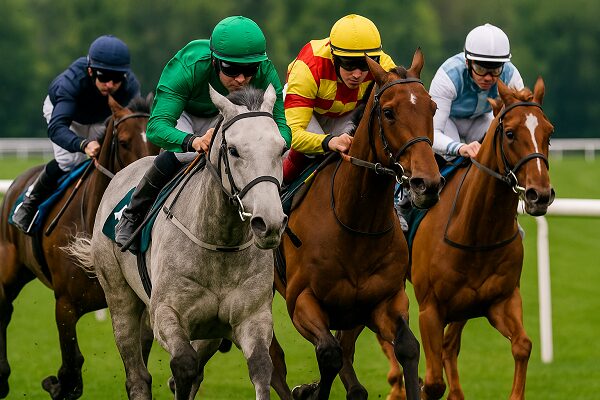The 2nd Favourite Horse Racing System: A Proven Approach for Picking Winners
Horse racing systems have been around for as long as people have been placing bets on the sport.
Punters love a theory that gives them a potential edge, whether it’s following trends, trainer stats, or race conditions.
Among the simplest — and surprisingly popular — is the 2nd favourite horse racing system.
But here’s the thing: not all second favourite systems are created equal. Some are too broad to work, while others, when applied with discipline and filters, can uncover genuine value.
In this article, we’ll break down how often second favourites win, what their returns looks like, and how smart filters can transform a simple system into a more effective betting strategy for backing second favourites.
What Is the 2nd Favourite Horse Racing System?
The concept is straightforward: instead of blindly backing the favourite in every race, you focus on the second favourite in the betting market.
This is the horse with the second-shortest odds, judged by bookmakers and punters to be the next most likely winner.
Why does this make sense? Because favourites are often “over-backed.” Bookmakers know the average bettor loves siding with the top pick, so odds are squeezed down.
That leaves the second favourite in a sweet spot — still fancied to win, but often at a price that offers better long-term value.
The logic for the second favourite horse racing system is simple:
- The favourite is often “over-backed” by casual punters.
- The second favourite, meanwhile, may offer better value because its odds are longer than the favourite’s but it still has a strong chance of winning.
- By targeting the second favourite systematically, you might be able to find a sweet spot between probability and price.
This idea has been around for decades and still appeals to bettors today because of its simplicity.
Why Focus on the Second Favourite?
To understand why the 2nd favourite horse racing system has such appeal, it’s worth looking at the dynamics of betting markets.
- The favourite bias – Bookmakers know that the average punter loves to back favourites. This often means that favourites’ odds are shorter than they should be, reducing long-term profitability.
- Better strike rate than outsiders – While backing long shots can bring huge wins, their strike rate is low. The second favourite sits in a sweet spot: not as risky as a 20/1 shot, but not as over-bet as the odds-on favourite.
- Historical performance – Studies of past races suggest that second favourites win more often than most punters realise. In fact, in many race types, they perform nearly as well as favourites but at more attractive odds.
- Flexibility – You can approach second favourites in different ways: backing them to win, each-way betting, or even laying them if you think the favourite is too strong.
How Often Do Second Favourites Win?
The first step in evaluating any system is to understand the baseline figures. How do second favourites perform in the long run?
- Strike rate: Second favourites win around 19–22% of races in the UK. That’s roughly one in five.
- Comparison: Favourites win closer to 30–35% of races, while long shots land far less often.
- Combined power: Between them, favourites and second favourites account for about half of all winners.
So second favourites clearly do win their fair share — but what about the bottom line?
The Returns for Backing Second Favourites Blindly
This is where reality bites. The return on investment (ROI) of backing all second favourites blindly is not so good.
- At Starting Price (SP): Backing every second favourite produces a negative ROI of 10-12%. This means for every £100 you bet, you would lose around £10-£12, on average, from backing all second favourites. The bookmaker’s margin (the “overround”) makes it impossible to make a profit from backing all second favourites blindly.
- At Betfair SP (BSP): The hit is smaller, but still not enough to be profitable without filters.
In short: the 2nd favourite horse racing system doesn’t work if you simply back every single one. But with the right tweaks, it becomes much more interesting.
A Tested Strategy: Backing Second Favourites in Handicaps
Whilst there is a certain attraction to backing second favourites, we don’t want to just be backing them blindly. This will lead to losses over time, as the stats above show.
What we want to do is find a method that identifies value second favourites, where their true chances of winning a race are higher than the odds suggest.
Below we will detail a strategy that could be used for backing second favourites, concentrating on certain conditions that can put the odds in our favour.
This second favourites horse racing system focuses on handicap races with medium-sized fields. Here’s how it works.
The Rules
- Race type: Stick to handicaps. These races are designed to even out ability by assigning weights, making favourites less dominant.
- Field size: Look for 8–14 runners. Too few horses and the favourite is usually strong; too many and results get chaotic.
- Favourite’s odds: Avoid races where the favourite is odds-on. When the market is that confident, the second favourite is usually second-best for a reason.
- Second favourite’s odds: Aim for the 2.75–5.50 (11/8 to 9/2) range. This “sweet spot” avoids very short-priced seconds (little value) and long shots (low strike rate).
- Market moves: Avoid second favourites that have been heavily backed (big “steamers”). Data shows these often underperform at the off.
- Execution: Place bets at Betfair SP or with a bookmaker offering Best Odds Guaranteed (BOG) to capture late drifts.
Why These Rules Improve the System
Each rule trims away conditions where the market is at its most efficient:
- Handicaps & 8–14 runners: More competitive, less market certainty.
- Avoiding odds-on favs: Stops you from opposing horses that genuinely dominate.
- Price band discipline: Keeps you in the zone where the favourite–longshot bias is smaller.
- Skipping steamers: Protects you from following hype-driven plunges that historically lose money.
- BFSP/BOG: Ensures you don’t lock in poor odds.
Example of the System in Action
Imagine three qualifying races in an afternoon:
- Race 1: 10-runner handicap. Favourite 7/4, second favourite 3/1. You back the 3/1 shot — it wins. Profit: +£30 (to £10 stakes).
- Race 2: 12-runner handicap. Favourite 2/1, second favourite 4/1. You back the 4/1 shot — it finishes 3rd. Loss: -£10.
- Race 3: 9-runner handicap. Favourite 9/4, second favourite 10/3. You back it — it wins. Profit: +£33.
Staked £30, returned £73. A nice net profit of £43.
Of course, not every day will look like that. But over time, this filtered system tends to give a much stronger return profile than simply backing every second favourite.
Find out who the Best Horse Racing Tipsters are here.
Improving Returns Further: Extra Filters to Test
Even after applying the core rules of the 2nd favourite horse racing system (handicaps, 8–14 runners, avoiding odds-on favourites, and using BFSP/BOG), there’s still room to sharpen your edge.
By layering in additional filters, you can weed out poor-value selections and home in on the most promising ones.
Here are some of the most effective refinements, with examples.
Trainer/Jockey Stats
Not all trainers and jockeys perform the same when it comes to winning with second favourites. Some stables excel at landing gambles with horses that aren’t the market leader.
- Example: A top flat trainer like William Haggas might have a strong record with second favourites in competitive handicaps, showing “wins above expected” compared to the market. On the other hand, a smaller yard might consistently underperform when their horses are second favourite, suggesting they’re overbet.
- How to use it: Keep a simple database or spreadsheet of trainer/jockey combinations and track ROI specifically for second favourites. Over time, you’ll spot which partnerships are worth following and which to avoid.
Race Type Splits
The performance of second favourites varies depending on whether the race is flat, all-weather, or jumps.
- Example: Second favourites in flat turf handicaps with 10+ runners may offer better value than in small-field novice hurdles, where the favourite often dominates.
- How to use it: Analyse your own betting records by code and distance. You might find that second favourites are more profitable in sprint handicaps, or perhaps in middle-distance flat races where tactical riding plays a bigger role.
Avoid Maidens and Novices
In races where most horses are inexperienced (maidens, novices, bumpers), the market often overestimates the ability of unproven runners. Favourites can be especially strong in these conditions, making second favourites weaker value.
- Example: In a novice hurdle with six runners, the favourite from a top yard may have been heavily schooled and is expected to win. The second favourite might be shorter than it should be, based only on potential, not proven form.
- How to use it: Stick to handicaps where horses have already shown their level of ability, and the weights even things out.
Ground Conditions
The going (firm, good, soft, heavy) is one of the most overlooked factors in market prices. A second favourite with proven form on the day’s going may be better value than a favourite who is untested on the surface.
- Example: On soft ground at Ascot, the favourite might be a flashy winner on good-to-firm but has never run on soft. The second favourite, meanwhile, has two wins on similar going. Here, the market may have mispriced their chances, and siding with the second favourite gives you an edge.
- How to use it: Always check a horse’s record on the going. You can filter bets to only back second favourites with at least one prior win or placed run on the surface.
Speed Figures
Time-based ratings (speed figures) can highlight horses that have already run to a higher level than the market suggests.
- Example: A second favourite might have recently clocked the fastest time of any runner in the field over the same distance, yet the market has priced it slightly longer than the favourite based on reputation or stable strength.
- How to use it: Services like Timeform, Topspeed, or other racing databases provide speed figures. If a second favourite is top-rated or close to it, that’s often a sign the market may have undervalued it.
Putting It All Together
By applying these filters, you can transform the 2nd favourite horse racing system from a blunt instrument into a sharp betting tool. For example:
- Race selection: 12-runner flat turf handicap
- Favourite odds: 2/1 (unproven on today’s soft ground)
- Second favourite odds: 7/2 (two wins on soft ground, strong speed figure last run)
- Trainer/jockey: Yard with a positive ROI on second favourites in similar races
That’s a scenario where all your filters align — and where the second favourite might represent genuine value.
An Alternative System: Laying Second Favourites in Small Fields
Not every punter wants to back horses. Some prefer laying them (betting against them). A neat variation is:
- Only in races with 5–7 runners.
- Favourite odds ≤ 2.20.
- Lay the second favourite.
The logic is simple: in small fields with a strong favourite, the second favourite is often overestimated by the market. By laying it, you profit when it doesn’t win — which is most of the time.
Caution: laying carries higher risk if your selection does win, so always control liability (e.g. 1% of bankroll per lay).
Bankroll Management for the 2nd Favourite System
No system works without discipline.
- Stake size: Bet 1–2% of your bankroll per selection.
- Keep records: Track strike rate, average odds, profit/loss.
- Stick to the rules: Don’t chase losses by bending filters.
Over the long run, discipline matters just as much as picking the right horses.
Final Thoughts
The 2nd favourite horse racing system is a classic for a reason. On a raw basis, second favourites win about 20% of the time — but without filters, they return a negative ROI, meaning they will lose you money over time.
By focusing on handicaps with 8–14 runners, avoiding odds-on favourites, and sticking to the right odds ranges, you can turn those numbers closer to break-even — or even into profit, with additional research to pinpoint value second favourites.
For more adventurous punters, laying second favourites in small fields is an intriguing alternative, though higher risk.
At the end of the day, the system won’t make you rich overnight, but it can give you structure, focus, and a sharper angle than simply following the crowd onto favourites. And in horse racing betting, small edges are exactly what you’re looking for.










Leave a Reply
Want to join the discussion?Feel free to contribute!